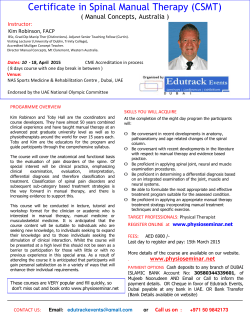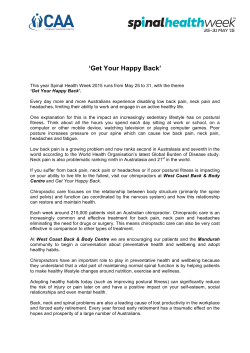
What to expect on your first visit For additional information We Accept
If you suffer from the following... + Pain After Surgery + Auto Accident + Headaches + Work Related Injury + Shingles + Strokes + Cancer Pain + Brain Injury + Diabetic Pain + Spinal Cord Injury + Arthritis + Decreased Circulation + Osteoporosis + Herniated Discs + Myofascial + Crps Pain + Fibromyalgia We can help! For additional information CFPM 2637 Cornerstone Blvd. Edinburg, Texas 78539 Next to Max Fitness Phone: (956) 631-9041 What to expect on your first visit A complete medical and physical exam will be conducted. Upon diagnosis a one-on-one discussion will take place to fully explain the best possible plan of care. All pain management programs are focused on the person, not just their pain. Office hours: Monday- Friday 8am - 5pm We Accept Private Pay, Medicare, Medical Insurance and all other Major Credit Cards. Center For Pain Management Dr. Tajul “Tim” Chowdhury M.D. Visit our website cfpm.net Call us at (956) 631-9041 or visit our website at cfpm.net Welcome to the Center for Pain Management. We aim to improve the health and quality of life for every patient, thereby contributing to a healthier, more productive, happier community and a brighter and more optimistic future for all. + Sensory Nerve Conduction Velocity Test Used to evaluate the function of the motor and sensory nerves. This test also diagnoses nerve damage. + Discogram Procedure using contrast dye that temporarily reproduces back pain symptoms allowing physician to identify which specific intervertebral disc is source of pain + Intradiscal Electrothermal Therapy (IDET) “My patients do not have to live with pain. they can LIVE WELL NOW!” Used to treat chronic disc-related low back pain caused by nerve fibers that have grown out of their normal location. + Implantation of Intrathecal Spinal Baclofen Pump An implant that relieves spasticity by delivering small amounts of medication straight into the spinal fluid space. What is Pain Management? A multidisciplinary approach that utilizes less conservative options to help people take an active role in managing their pain and regaining control over their lives. + MILD (Minimally Invasive Lumbar Decompression) Small pieces of bone and excess ligament tissue are removed restoring space in the spinal canal and decreasing the compression of the nerves reducing pain and resotring mobility. Other treatments include: + Balloon Kyphoplasty: Treatments + Chronic Pain Program Pain management and stress management groups that teach patients the factors that can impact pain. + Epidural Steroid Injections Treatment for spinal nerve inflammation. + Trigger Point Injections Treat painful areas that contain knots of muscle that form when muscles do not relax. + Nerve Blocks “Turn off” the pain signal coming from specific locations in the body. + Facet Block An injection that anesthetizes the facet joint and blocks pain. (Facet joints are the small joints located at each segment of the spine that provide stability and help guide motion) + Radio Frequency Denervation Deactivates nerves around painful parts of the spine. + Myelogram Procedure using contrast dye followed by CT scan to help access problems in spinal canal. + Implantation of Intrathecal Spinal Narcotic Pump Commonly known as a morphine pump, this implant delivers a concentrated amount of medication into the spinal fluid space. The most common cause of compression fractures of the spine is osteoporosis. Women, 55 years of age or older, cancer patients or an injury that caused broken bones in the spine may need this procedure. In a compression fracture, all or part of a spine bone collapses. Balloon kyphoplasty is an outpatient procedure used to treat painful compression fractures in the spine, helping restore the strength and stability of the vertebrae. Orthopedic balloons and bone cement are used to repair the spinal fracture. The balloon is placed through the needle into the bone and then inflated, this restores the height of the vertebrae. Cement is then injected into the space creating an internal cast. Patients who undergo kyphoplasty usually report less pain and increased mobility immediately following the procedure. + Spinal Column Stimulator: Spinal cord stimulation (SCS). In spinal cord stimulation, soft, thin wires with electrical leads on the ends are placed through a needle in the back near to the spinal column. The leads are placed through a needle inserted into the back (no incision is required). A small incision is then made and, programmable generator is placed in the upper buttock or abdomen (under the skin) which emits electrical currents to the spinal column. Many patients find that they can decrease or stop taking pain medications after undergoing spinal cord stimulation. Given these benefits, there has been ongoing investment and advances in spinal cord stimulation technology, and many individuals suffering from chronic pain find that neurostimulation positively impacts the quality of their lives. All patients will undergo a trial version of a stimulator. Tim S. Chowdhury, M.D. Diplomate of the American Academy of Pain Management Diplomate of the American Academy of Disability Evaluating Physicians Over 30 years of professional experience in the specialty of anesthesia and over 20 years of professional experience in the subspecialty of comprehensive and interventional pain management.
© Copyright 2025





















